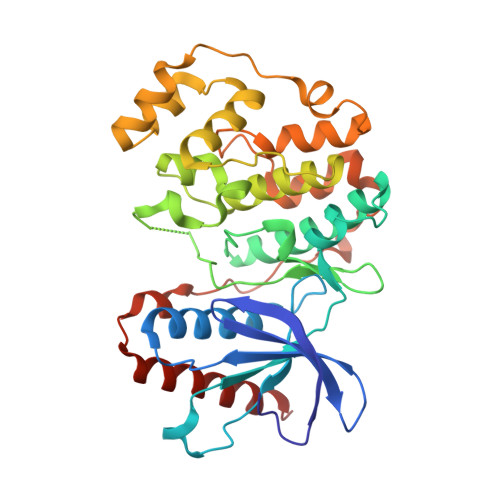Discovery of a novel allosteric inhibitor-binding site in ERK5: comparison with the canonical kinase hinge ATP-binding site.
Chen, H., Tucker, J., Wang, X., Gavine, P.R., Phillips, C., Augustin, M.A., Schreiner, P., Steinbacher, S., Preston, M., Ogg, D.(2016) Acta Crystallogr D Struct Biol 72: 682-693
- PubMed: 27139631
- DOI: https://doi.org/10.1107/S2059798316004502
- Primary Citation of Related Structures:
4ZSG, 4ZSJ, 4ZSL, 5BYY, 5BYZ - PubMed Abstract:
MAP kinases act as an integration point for multiple biochemical signals and are involved in a wide variety of cellular processes such as proliferation, differentiation, regulation of transcription and development. As a member of the MAP kinase family, ERK5 (MAPK7) is involved in the downstream signalling pathways of various cell-surface receptors, including receptor tyrosine kinases and G protein-coupled receptors. In the current study, five structures of the ERK5 kinase domain co-crystallized with ERK5 inhibitors are reported. Interestingly, three of the compounds bind at a novel allosteric binding site in ERK5, while the other two bind at the typical ATP-binding site. Binding of inhibitors at the allosteric site is accompanied by displacement of the P-loop into the ATP-binding site and is shown to be ATP-competitive in an enzymatic assay of ERK5 kinase activity. Kinase selectivity data show that the most potent allosteric inhibitor exhibits superior kinase selectivity compared with the two inhibitors that bind at the canonical ATP-binding site. An analysis of these structures and comparison with both a previously published ERK5-inhibitor complex structure (PDB entry 4b99) and the structures of three other kinases (CDK2, ITK and MEK) in complex with allosteric inhibitors are presented.
Organizational Affiliation:
Chemistry Innovation Centre, Discovery Sciences, AstraZeneca R&D Mölndal, 431 83 Mölndal, Sweden.















